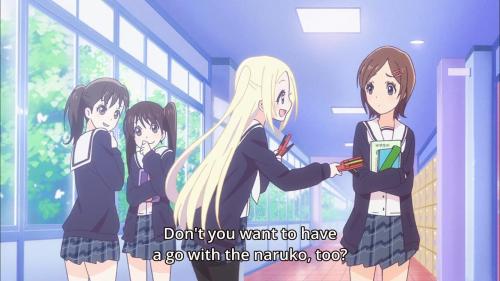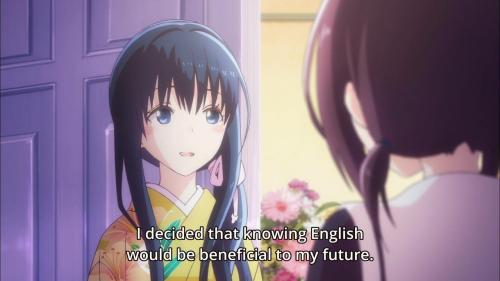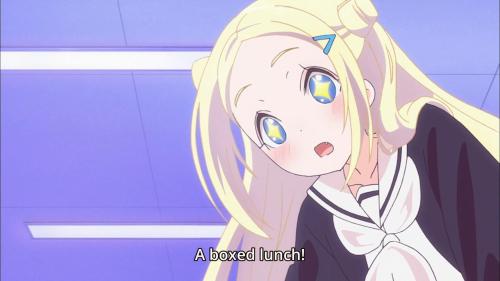The really frustrating thing about watching Hanayamata is the fact that all of the characters are so hard to convince to join the Yosakoi club. Seven episodes in and we’re still not playing with a full deck. It used to bug me until I started thinking more about it, and I realized that the story Hanayamata is telling is a lot more complex than I thought at first. It all comes down to the dominant theme of the show: the clash of foreign cultures, and how it can illuminate the absurdity of social conventions, and ultimately help us challenge the things that we take for granted.
 |
| Spoilers in the OP. |
Consider the way Hana and Naru parallel one another. One of the first things we learn is that Naru is a girl who is obsessed with Western fairy tales, much to the chagrin of her father who sees them as a waste of time. She fondly remembers the first time she saw Disney’s Cinderella in the movie theatre, and secretly hopes that one day she will meet a fairy who will make her “dazzling.” In fact the idea is so deeply ingrained in her mind that the first time she actually sees a white person, she thinks it must be a fairy, and chases after her.
The “fairy” is actually Hana, a girl from America who is obsessed with Japanese culture, and in particular traditional Yosakoi dancing. After the two become friends, Hana’s stereotypical American shamelessness causes Naru so much embarrassment that she starts avoiding her. Hana doesn’t understand why her beloved Japan isn’t full of people who share her zeal for what she naively considers “Japanese culture,” and she’s completely oblivious to how ridiculous she looks as a loud, obnoxious white girl who wants to start a Yosakoi club.
 |
| Hey, Japanese people! Act more Japanese! |
However, while most of the girls in the school clearly don’t want to join the Yosakoi club, even the ones who do want to find themselves unable to because of cultural barriers that stand in their way. For the stereotypical American Hana, “I want to start a Yosakoi club” is reason enough for her to do it, regardless of what other people think. She even tells Naru early on that she will dance Yosakoi even if she’s the only one doing it, and you can tell she really means it. But “this is what I really want to do” isn’t reason enough for the other girls to join her, and each of them has to struggle to overcome the anxiety of breaking the mould and doing something selfish.
Tami and Naru both feel this way, and both of them hide their interest in Yosakoi from their fathers at first out of fear of disappointing them. Their club sponsor even refuses to sign them up until they prove that they can keep their grades above a certain level. All of the barriers that get thrown in the way of the Yosakoi club’s success can get a little tiresome while watching the show, but the point seems to be to underline exactly how much the girls are sacrificing just for the sake of this silly club that they started on a whim. Even their club sponsor, Sally-chan, has a cultural barrier: she’s unmarried and in her twenties, and worries that if she gets involved in the club she won’t have enough time to find a husband.
 |
| Tami is weighed down by her obligations. |
Of course, none of these things make any sense to Hana, who is totally unfamiliar with the oppressive culture of success in Japan, and doesn’t see why everyone doesn’t immediately embrace her carefree individualism.
Anyhow, these themes inform the motives of the characters, and keeping them in mind is the key to understanding the reasons that they behave the way they do in the series. If you view Hanayamata while keeping in mind the foreignness of Hana, how embarrassing she is to be around, how ridiculous her club idea is, and how paranoid all the Japanese girls are about doing something impulsive and selfish contrary to the wishes of their parents and modern society, it starts to come together as a nice, delightfully complex narrative. Especially the inherent absurdity of them using traditional Japanese dance as a vehicle for social rebellion.
 |
| Ooh, “Bento!” Just like in anime! |
We’ve already seen the character arcs of a few of the characters flaring up. Tami standing up to her father, though it may not have been final, was powerful. What else will happen? Will Sally-chan learn that it’s okay to be an unmarried twenty-something, or will she (probably) fall for the also-unmarried Yosakoi store manager? Will Naru learn to pursue her own desires in spite of what’s best for her future? Will Hana actually show any growth at all, or will she continue to be a walking American stereotype and plot catalyst? There’s really a lot going on here, and you can’t just watch it the way you’d watch Free!, or you’ll be missing out on the whole story the show is actually telling.
Then again, once we actually do get down to the business of Yosakoi dancing, I’m going to be pretty happy. The opening sequence is such a tease.

Nice article. Never did pickup on the social rebellion theme, but now that you pointed it out, it is apparent and kind of reminds of something I read about the Hip Hop movement in Japan for my anthropology class years back. Even though some of the American subject didn’t appear in various rapper’s compositions, things like family obligation and societal pressures did. As globalization become more prevalent, some the physical styles (hair, clothing, etc) was adopted for the cool factor and means for expressing individuality. Guess you can kind of equate that to some of the youth culture today in Japan (or elsewhere for matter) as outlets to escape societal expectations. Anyway, I’m enjoying the show so far (could tone down the melodrama), but like yourself: want to get to the dancing :3
LikeLike
Thank you. I didn’t realize there was a hip-hop movement in Japan, that’s interesting, and I can see how it would look a lot different from the way it is in the West. Really there’s a lot we take for granted over here in terms of the culture of autonomy.
Hopefully dancing next week. At least they have costumes, kind of!
LikeLike
This is an interesting analysis of the series! I’m a Yosakoi dancer and researcher, so I’d like to add a bit of info and ask your resulting opinion. Yosakoi is actually relatively new to Japan, created around 1954 as part of an effort cheer up post-WWII Japan. Many of the groups combine tradition and modern dance styles for their choreography, but there are no set rules for what sort of moves are required.
In terms of social acceptance, some dancers go through the same or similar experiences as the characters in the show. When we (dancers) practice and socialize with our team, however, we form strong, cohesive bonds. This is largely due to the fact that our teammates are among the few people where we can be ourselves – they’re a place where we don’t have to hide.
The practicing of Yosakoi in Hanayamata may be form of social rebellion, but I believe it is also a way to find complete acceptance of the self with minimal impact from the community. We see in various scenes that the five main characters don’t feel completely comfortable with their family, largely based around fear of judgement/disappointment. Yosakoi, however, becomes their method of self-expression (not “This is what I’m feeling” , but “This is me! This is who I am!”) and evolves into a way they can present themselves to others and be accepted for it.
Hope this all makes sense since I’m writing this at 2 AM! (>_<)
LikeLiked by 1 person